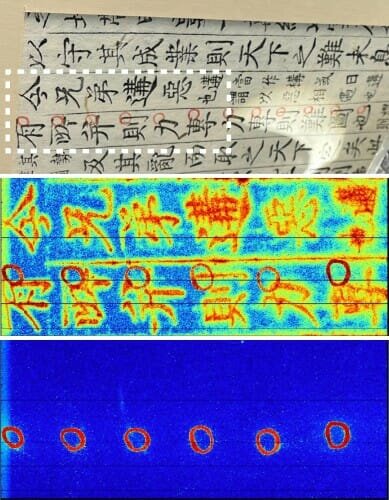A photograph of a scanned Korean text. The white dotted box indicates the areas shown in the middle and bottom panels. Each element produces a unique X-ray fluorescence. After scanning the text, the researchers applied filters for the known XRF patterns of different elements and created a color-coded heat-map of their abundance, from lowest (blue) to highest (red). An element found in only small quantities is in the red circles in the bottom part of the image.Credit: Minhal Gardezi

1 posted on
08/14/2022 2:42:18 PM PDT by
SunkenCiv
To: SunkenCiv
Gutenberg’s use of the printing press generally marked the end of the medieval period and the beginning of the Renaissance. Books and the printed word would soon become available to everyone not like before when mostly the wealthy, royalty and the Church could afford books.
At the same time Gutenberg was printing the Bible, in Mainz, Germany, a monk began handwriting the Bible. It took him 18 months to handwrite one Bible. Gutenberg was able to print about 180 copies in the same amount of time.
Bonus trivia: books printed before 1500 are called incunables or incunabulae. A book printed before 1500 is an incunabulum.
4 posted on
08/14/2022 2:54:37 PM PDT by
KingLudd
To: SunkenCiv
It is possible Guttenberg heard about the Korean printing press from traders? Yes. However, given the distances involved at that time, there is almost no chance he got to examine a working model.
5 posted on
08/14/2022 2:54:46 PM PDT by
rbg81
To: SunkenCiv
I regard this as being an analog to the difference between Columbus and all of the previous encounters with the Western Hemisphere, it was Columbus that made the ‘discovery’ permanent. Yes, there were earlier seafarers like the Vikings and others BUT it was the Columbus voyages and the technology of his era that made his the last ‘discovery’!
The same applies to the Gutenberg SYSTEM development, the press, the metallurgy for the type, the paper & binding for the pamphlets & books AND the burgeoning wealth & literacy that created the market. What tends to be forgotten is that the examples from Asia came from monolithic cultures where there was little incentive to grow this technology. In the mid-1400s Europe, with religious wars being propagandized (consider Luther’s attack on PRINTED indulgences) and multiple polities as well as the growing literacy in Europe, the Gutenberg Press was a spark against dry tinder!
A query; Would Columbus’ and his follow-on explorers been the same level of permanency WITHOUT the Gutenberg to publicize it?
10 posted on
08/14/2022 4:09:41 PM PDT by
SES1066
(More & more it looks like Brandon's best decision was Kamala! UGH!)
To: SunkenCiv
“In 15th-century Germany, Johannes Gutenberg developed a printing press, a machine that allowed for mass production of texts. It is considered by many to be one of the most significant technological advancements of the last millennium.
Though Gutenberg often receives credit as the inventor of the printing press,”
article written by ignorant moron ... printing presses were already the standard for mass reproduction ... Gutenberg’s revolutionary invention was the use of moveable type ...
12 posted on
08/14/2022 4:24:43 PM PDT by
catnipman
(In a post-covid world, ALL "science" is now political science: stolen elections have consequences)
FreeRepublic.com is powered by software copyright 2000-2008 John Robinson
